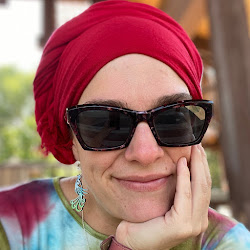Now, I am fully aware that the origins of this holiday were largely connected to the harvest -- the Festival of Weeks (since Shavuot means weeks in Hebrew), which began with the harvesting of barley during Pesach and ended with the harvesting of wheat during Shavuot, is the conclusion of the festival of the grain harvest. Perhaps the more commonly and widely observed aspect of the holiday, however, is that Shavuot is the commemoration of the giving of the Torah at Sinai. Furthermore, it's become a big holiday for consuming oodles of delicious dairy delicacies, which is something I can really wrap my fingers around. Now, there are no Torah prescriptions for this holiday outside of abstention from work, special prayer, and holiday meals, but that hasn't stopped us from really taking on the many traditions of the day (or two in the Diaspora). There is a great mnuemonic device that is used to remember these customs: acharit (אחרית, "last")
- אקדמות – Akdamot, the reading of a liturgical poem during Shavuot morning synagogue services
- חלב – Chalav (milk), the consumption of dairy products like milk and cheese
- רות – Ruth, the reading of the Book of Ruth at morning services
- ירק – Yerek, the decoration of homes and synagogues with greenery
- תורה – Torah, engaging in all-night Torah study.
Of course, perhaps the biggest treat for me during Shavot is the reading of Ruth, if for no other reason than that Ruth is the tour de force name issued when it comes to converts -- she's sort of the mother of converts everywhere. Her name is issued often, as even after her husband died and she was asked by her mother-in-law Naomi to turn back to her family, Ruth followed Naomi all the way back to the land, stating fervently, "Your people shall be my people, your G-d shall be my G-d." Those, folks, are the magic words! I could write a lot more about Ruth, Naomi, and their fabled relationship, but we'll save that for another time and place.
As for where the dairy consumption comes from, there are a few different ideas behind the tradition. One of the most interesting, I think, is that since we didn't have the laws of how to properly butcher animals, the Israelites opted instead to eat dairy until Moses returned from receiving the laws. Makes sense, no? Another idea is that the tradition comes from the fact that Israel is referred to many times over as the land flowing with "milk and honey." Even further, the gematria (numerical value) of milk -- chalav -- is 40, which commemorates the 40 days and nights that Moses spent atop Sinai. Fascinating!
Right now, the internet is flowing with lots of blog posts on Shavuot, and as the holiday approaches this evening, Jews everywhere prepare to shut down their computers and cell phones to take on the two day chag -- after all, Shavuot is two days, but since it falls during Shabbos, it's really two days Shavuot mixed in with some Shabbos. Talk about an exciting few days.
Until then? I'll continue to watch the Spelling Bee on ESPN, dream of cheesecake, and nosh kosher berry muffins.
Chag sameach! May your chag be filled with study, prayer, dairy delicacies, friends, family, and peace.






